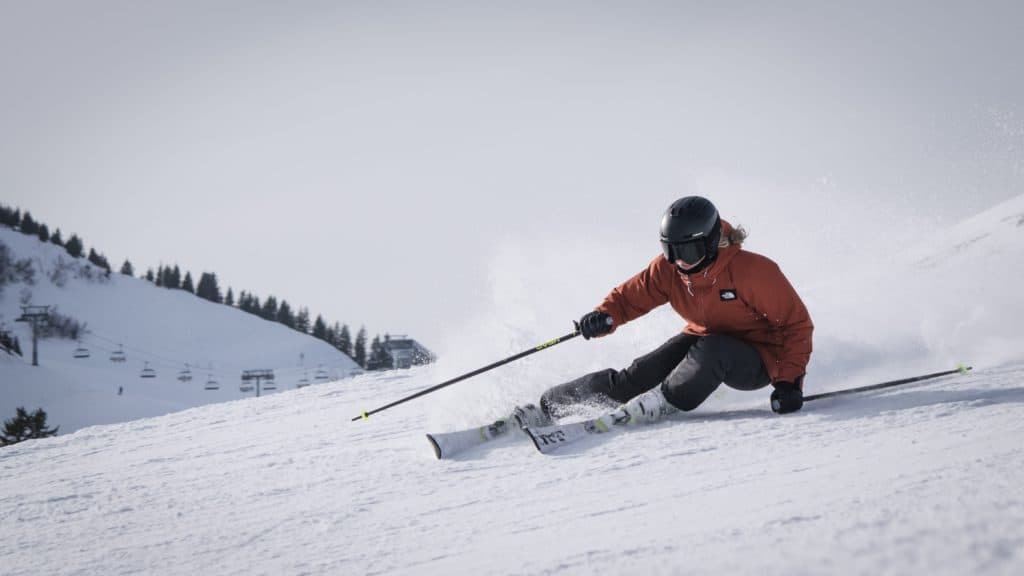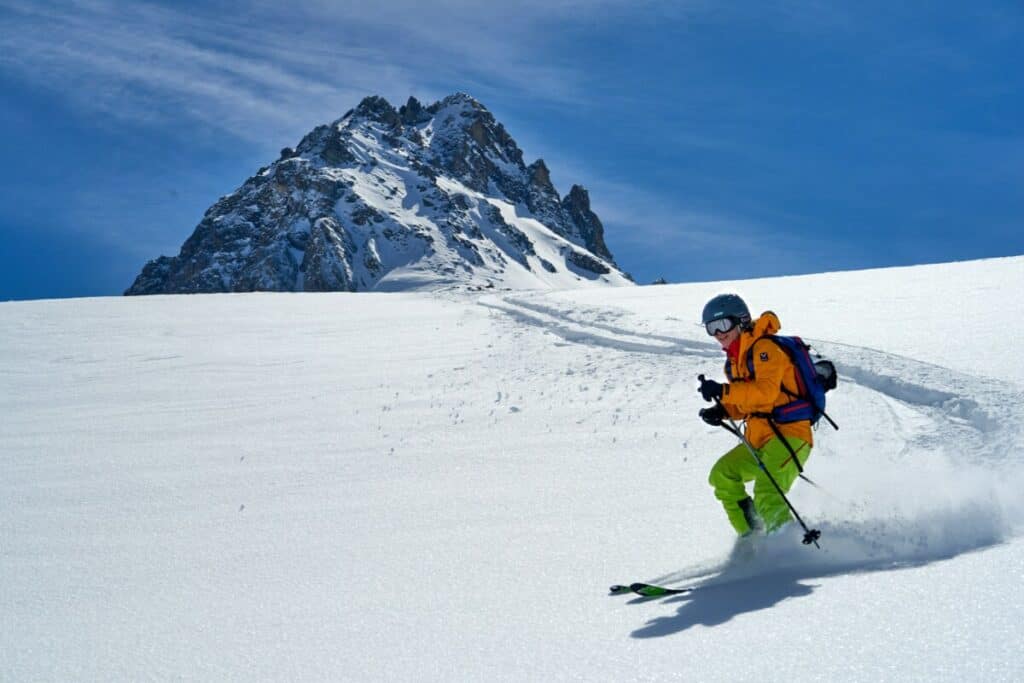Traditionally, skis were completely straight, with no bends, curves or arches. It was a different sport then.
Today when we talk about ski profile, you will hear the terms camber, rocker and hybrid. These terms are referencing the shape underneath the base of the ski.
It’s important to understand ski profile as it directly affects how the ski will perform. In this guide, I explain how ski profiles work and how it will affect your skiing.

Disclaimer: Some links in this article are affiliate links, which means that if you purchase through them I receive a small commission, at no extra cost to you. This helps cover the cost of running this blog. Thanks for your support!
What Is Ski Camber?
Camber is the convex shape observed under the ski when it is placed flat on the ground. Traditional camber begins just behind the tip (front) of the ski and runs through to the tail (back) of the ski.
Generally the amount of Camber in a ski will be between 3 mm and 5 mm. This is measured by laying the skis on a flat surface and taking a measurement from the bottom of the ski to the flat surface.
Modern skis have used underfoot camber for many years since it helps hold a carve turn and provides stability at speed. These days it’s referred to as traditional camber and this is the profile most skis use.

Benefits of Camber in Skis
- Aids with stability at speed.
- Helps the skier hold the ski in a turn. ie carving.
- Gives the skis spring or “POP”. The level of pop will be a combination of camber and the stiffness of the ski. This is particularly useful for jumps.
Downsides of Camber in a Ski.
- Easier to catch an edge ie fall over.
- Doesn’t provide as much float in powder.
- Les manœuvrable at slower speeds.
What Is Ski Rocker? (Reverse Camber)
Rocker is another word for reverse camber. This is where the bend in the ski goes the opposite way to camber ie converse.
In more recent years, reverse camber or rocker has increasingly been used to create skis with a variety of characteristics. Rocker helps skis float in powder snow and initiate turns.
Many modern skis will use a combination of camber and rocker in order to cater for the many disciplines and styles of skiing.

Benefits of Reverse Camber Skis
- More float in deep snow
- More manouverable at slower speeds
- Less likely to catch an edge.
Downsides to Rocker on Skis
- Less stable at speed
- Won’t hold an edge so well, ie carving.
- Less spring/pop
Related Reading
Hybrid (Camber and Rocker)
Hybrid Camber refers to a combination of camber and reverse camber. This can be achieved in a few different ways.
Most hybrid skis will involve having camber underfoot for stability, combined with rocker at the tip for float and easy turns. They can also have rocker to the tail of the ski which is also useful for float and easy turns or even skiing backwards when freestyle skiing.
These skis characteristics are described as rocker/camber profile.
Most hybrid profile skis will fall into the category of all mountain skis, some of which will best suit piste skiing and others more powder orientated.

How Skis Profile Will Affect My Skiing or Ski Choice
Traditional Camber Skis (Full camber)
Best For: On piste, competition
Nearly all skis these days will have an element of camber to them. When a turn is initiated the camber will help the skier sustain a stable turn.
A full camber ski will have a camber along its full length from tip to tail and is best suited for carving turns on a piste. It will also be very stable at speed.
They will be well suited for piste skiing, especially on hard or icy surfaces. Ski racing disciplines will also use full camber skis.
For recreational skiers, they will best suit those who prefer sticking to the groomed runs, perfecting their technique on piste and for those who like skiing fast on piste.
Beginners and intermediates might find they are harder to use and more likely to catch an edge than a ski with a hybrid profile. (see below)

Rocker Skis (Reverse camber)
Best For: Deep powder
It is possible to have a full rocker ski but because of its lack of camber, they are quite unstable on a hard piste and at speed. They do, however, give good float and control in deep powder.
A full rocker ski will most likely be used by experienced skiers, skiing powder all day. They suit Heli or Cat skiing.
Most skis with rocker will fall into the category of hybrid (below)

Hybrid Skis (Camber and Rocker)
Tip Rocker
Best For: All mountain, all skill levels
This is where the ski will have camber underfoot with a rocker profile towards the tip of the ski. This makes them ideal for powder and all mountain skiing.
This profile is good for intermediates and casual skiers who enjoy cruising the groomers, though it also has the ability to handle mixed conditions and blast around in the powder if it’s available.
Tip and Tail Rocker
Best For: Powder, all mountain, freestyle, all skill levels.
Tip and tail rocker skis again have camber underfoot but rocker at the tip and tail of the ski. Many all mountain skis will have this profile as it will allow for some stability on the piste and also perform well in a variety of snow conditions.
This profile can be useful for beginners as the camber gives an element of stability alongside the rocker, which will make the skis easier to turn and be more forgiving (less likely to catch an edge).
The camber in this profile provides good pop for freestyle skiers whilst at the same time the rockered tip and tail will allow for silky smooth butters.
The amount of camber and rocker can vary considerably, so this profile can be tailored to suit many skier profiles and create a ski to perform in a wide range of conditions.

Flat (No camber or Rocker)
Best for: Specialist use.
It is possible to find skis with no camber ie flat underfoot. These are most likely to be used for specific competitions such as speed skiing.
Also flat profiles can be incorporated into a hybrid profile setup such as rocker/flat/rocker, which may suit a beginner or perform well in powder.

Summary: Rocker vs Camber Skis
The profile of a ski will affect how the ski performs. Traditional camber skis are best suited to carving on groomed runs whereas rocker skis shine in deep powder.
Beginners will benefit from a hybrid tip and tail rocker since that provides a little stability from the camber whilst the rocker at tip and tail makes edge catching less likely.
For intermediate skiers a hybrid camber/rocker, all mountain ski will be most suitable since this gives a versatile performance in a variety of conditions. Hybrid skis are also easier to use, allowing the skier to stay on the hill for longer.
Keen skiers may have more than one set of skis, in which case they may opt for a dedicated piste ski (camber) and/or a dedicated powder ski (rocker). This way they have a specific ski to suit the conditions or type of skiing they will be doing.
Ski development is ongoing so there are also other profiles being implemented such as skis with different camber profiles on each edge of the ski. The ultimate all mountain ski will always be the one that best suits the skiers ability, style and preferences.
Also, bear in mind that the camber/rocker profile of a ski is just one of several features that go into the ski design, so it’s important to consider all ski attributes before selecting a ski to best suit your needs.
Before choosing which ski is best suited to you, take a look at the following guides:
